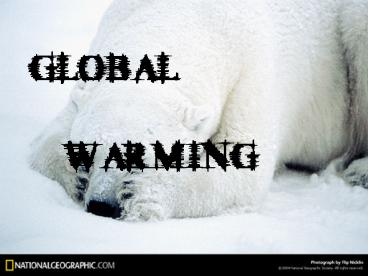Climate change Health effects Direct Temperature Effects PowerPoint PPT Presentation
1 / 35
Title: Climate change Health effects Direct Temperature Effects
1
GLOBAL WARMING
2
Global Warming
- an average increase in the temperature of the
atmosphere near the Earths surface and in the
troposphere1, which can contribute to changes in
global climate patterns
3
Causes
- Burning of fossil fuels (Coal/Crude oil)
- Power plants? generate electricity
- Transportation-----fuels for transports (E.g.
LPG, - kerosene, fuel oil)
- Industrial processes (E.g. manufacture of
- cement, steel, aluminium)
4
Causes
- Other greenhouse gases emission
- Agriculture
- Forestry
- Other land uses
- Waste management
5
Example Using natural gas to cook CH4 2O2 ?
CO2 2H2O
Besides carbon dioxide, other gases such as
methane, chlorofluorocarbons, nitrogen oxides and
ozone also contribute to the greenhouse effect.
6
- Greenhouse gases in the atmosphere
- ?
- Some infrared radiation is trapped
- ?
- Greenhouse effect
Serious greenhouse effect Global Warming
7
How serious the problem is?...
8
Increase in greenhouse gases
- Concentration of greenhouse gases in the
atmosphere is highly increasing by human
activities - ? Leads to the increasing seriousness of global
warming
9
(No Transcript)
10
Global surface temperatures
- increased about 0.6C/century since the late19th
century - increased to 2C/century over the past 25 years
11
Increase in Global temperatures
12
Temperature difference between different parts of
atmosphere
- troposphere temperatures (the lowest 8 kilometers
of the Earth's atmosphere) collected since 1979
also indicate warming - Cooling effect in higher parts of the atmosphere
stratospheric temperatures have been decreasing
13
(No Transcript)
14
(No Transcript)
15
NOT globally uniform warming
- Warming parts
- North America
- Eurasia
- Cooling parts
- parts of the southeastern U.S.
16
(No Transcript)
17
Increasing temperature extremes
- Regions that have temperatures (1-3C) warmer
than the average - United States
- Most of the Europe
- Regions that have temperatures (1-3C) cooler
than the average - Australia
18
Regional Temperatures
19
Sea level rising
- rising at an average rate of 1 - 2 mm/year over
the past 100 years
20
Environmental and Human Effects
21
(No Transcript)
22
Direct Temperature Effects
- Increase in average temperature
- More extreme heat waves during the summer Less
extreme cold spells during the winter - Harmful to those with heart problems, asthma, the
elderly, the very young and the homeless
23
Extreme Events
- Extreme Events
- Heat waves Cold waves Storms Floods and
Droughts - Global warming
- An increase in the frequency of extreme events
- More event-related deaths, injuries, infectious
diseases, and stress-related disorders
24
Climate-sensitive diseases
- Increase the risk of some infectious diseases
- particularly that appear in warm areas are
spread by mosquitoes and other insects - E.g. Malaria, dengue fever, yellow fever,
encephalitis - Algal blooms occur more frequently as
temperatures warm (particularly in areas with
polluted waters) - Diseases (e.g. cholera) accompanying algal blooms
become more frequent
25
Air Quality
- An increase in the concentration of ground-level
ozone - Damage lung tissue
- Harmful for those with asthma and other chronic
lung diseases
26
Food supply
- Rising temperatures and variable precipitation
- Decrease the production of staple foods in many
of the poorest regions - Increasing risks of malnutrition
27
Population displacement
- Rising sea levels
- Increase the risk of coastal flooding
- (Necessitate population displacement)
- More than half of the world's population now
lives within 60km of the sea. - Most vulnerable regions Nile delta in Egypt, the
Ganges-Brahmaputra delta in Bangladesh, many
small islands, such as the Maldives, the Marshall
Islands and Tuvalu.
28
UV Exposure (Australia)
- Skin Cancer
- an abnormal growth of skin tissues.
- Premature aging
- make the skin thick, wrinkled, and leathery
- Cataracts
- No longer have transparent lenses in their eyes
29
UV Exposure (Australia)
- Other Eye Damages
- Skin cancer around the eyes
- Degeneration of the yellow spot
- Suppression of Immunity
- Overexposure to UV radiation ? suppress proper
functioning of the body's immune system and
natural defenses of skin - UV-B radiation weakens the immune system ?
increases the chance of infection and disease
30
Measures on controlling the problem
- Government
- set some laws to limit the amount of
pollutants produced by factories - develop the skills of using renewable fuels,
e.g. solar energy, wind energy
31
Measures on controlling the problem
- encourage the factories to replace fossil
fuels by renewable fuels, which would not cause
environmental pollution - carry out energy saving scheme ? reduce the
pollution produced by burning fossil fuels - build more plants ? reduce the pollutants
e.g. CO2
32
Measures on controlling the problem
- Citizens
- reduce the use of plastic bags ? as burning
plastic emit CH4 - recycle the resources, e.g. plastic
- reduce the use of sprays ? as CFCs would be
emitted out
33
Measures on controlling the problem
- reduce the use of air-conditioner, which will
emit CFCs - use public transportation instead of private
cars ? reduce the pollutants emitted by cars
34
Sources
- http//www.who.int/globalchange/climate/en/
- http//resources.emb.gov.hk/envir-ed/text/globalis
sue/e_m2_2_6.htm - http//epa.gov/climatechange/effects/index.html
- http//www.tchps.edu.hk/greenweb/greenMaindGMsg5.h
tm - http//www.ncdc.noaa.gov/oa/climate/globalwarming.
html
35
THE END

